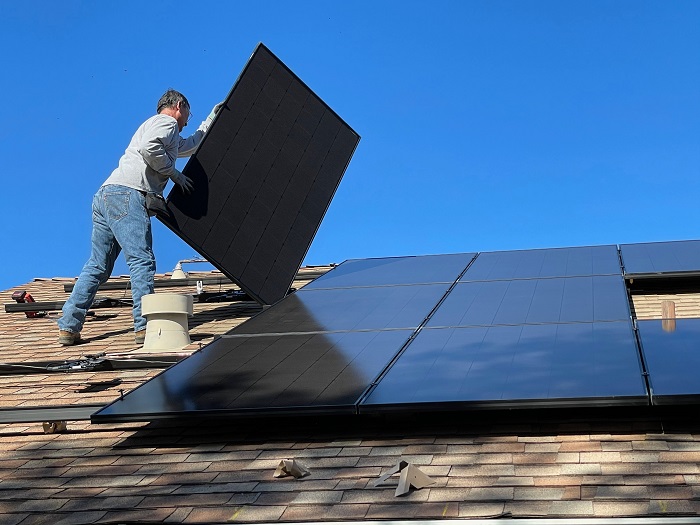Many of us are making lifestyle changes in order to protect the planet. Our homes are a big source of carbon emissions – by making a few home improvements, you could drastically reduce your carbon footprint.
In many cases, such home improvements won’t just save the planet, but will also save you money in the long run. On top of lowering your bills, you could increase the value of your home, with easy eco-friendly improvements.
But just which home improvements really make a difference? This post lists some of the most impactful ways to improve your home in an eco-friendly way.

LED light bulbs
If your home still has old incandescent light bulbs, a simple eco-friendly improvement could be to replace them with LED bulbs.
While these bulbs are slightly more expensive to buy, they require a lot less energy to light up, saving you money on your electricity bills while reducing your home’s carbon emissions. LED bulbs also last longer than incandescent bulbs, so won’t be replacing them as often.
Smart HVAC
Traditional HVAC systems use a thermostat that has to be manually adjusted. Smart HVAC systems can be programmed to turn on and off at certain times or automatically adjust depending on factors like room temperature or your monthly budget.
As a result, it’s much easier to save money and energy using these systems – by programming the right settings, you can reduce wasted energy in your home.
Solar panels
Solar panels are arguably the most eco-friendly and economical home improvement you can make. By running your home’s power off the sun, you can reduce your reliance on mains energy. You may even be able to take your home off-grid so that you never have to pay an energy bill again. You can also rely on solar energy being clean and sustainable (no burning off fossil fuels).
While solar panels aren’t cheap to install, you’re likely to make your money back over the years. In the long run, you could save huge amounts of money, while also drastically reducing your carbon emissions. A solar energy company will be able to handle installation for you. Solar panels typically require little maintenance except for occasional cleaning.

Greywater recycling system
Greywater is the waste water that goes down your shower and sinks. This waste water can be recycled for purposes such as flushing toilets or sprinkling the lawn using a greywater recycling system.
Such systems can save you money on your water bill, while also preserving freshwater in areas prone to droughts. There are specialist plumbing companies that can install greywater recycling systems for you. Greywater recycling systems can cost a lot of money upfront, but like other home improvements on this list they are an investment that pays off.
Loft insulation
Heat naturally rises. If your loft isn’t insulated, you’re likely to lose a lot of your heat through your roof. An insulated roof can help to reduce this heat loss. If you live in an area that receives cold winters, you could find that you don’t have to crank up the heating as often to keep your home warm, helping to reduce your energy consumption and save the planet.
There are many different ways to insulate a loft. Cold loft insulation involves insulating the floor of the loft, while warm loft insulation involves insulating the ceiling of the loft – the latter tends to be better if you don’t want your loft to get cold. There are lots of materials you can use to insulate a loft including sheep’s wool, fiberglass matting, foiled back felt, wooden boards or blown-on insulation – it’s worth comparing these different materials. You can hire contractors to install insulation or you can do it yourself.
Double-glazing
Most older homes were built with single-glazed windows. Upgrading to double-glazed windows could help to reduce heat loss in your home. These windows consist of two layers of glass with a layer of trapped argon gas in between, which helps to stop heat passing through. As with loft insulation, this can help your home stay warmer longer in the winter months so that you don’t have to turn up the heating as often, reducing your energy bills and carbon footprint.
Double-glazed windows should be installed by a professional. It’s possible to go one step further and opt for triple-glazed windows, but these are typically only necessary in much colder climates.
Cool roofing
A cool roof is designed to reflect sunlight. This prevents the building from absorbing heat so that it stays cooler longer, preventing the need to use as much air conditioning. Unlike loft insulation which is better suited for cooler climates, such roofs are recommended in warmer sunny climates.
Cool roofs are typically made from felt or fiberglass – it’s worth comparing different materials to find the most affordable and effective one. Installing a cool roof is a big job. However, in the long run you’ll save money on your energy bills by not having to use as much air con, plus you could help to significantly reduce your home’s carbon emissions.
Energy-efficient appliances
Appliances such as ovens, dishwashers, refrigerators, washing machines and tumble dryers contribute to much of our home’s energy consumption. When choosing appliances, it’s worth looking for energy-efficient models.
All modern appliances must come with an energy rating. This gives you a good idea of just how energy-efficient an appliance is. Energy Star certified appliances are some of the greenest options.
Rainwater harvesting tanks
In areas with hotter drier climates, as much as 50% of a home’s water consumption can go into watering plants and lawns. Rainwater harvesting involves collecting rain in a barrel for backyard use. By using less mains water, you can preserve freshwater and reduce your water bill.
Rainwater harvesting tanks are often attached to runoff pipes, collecting water that runs off the roof. Compared to many home improvements they are relatively cheap to buy and install – you can pay as little as $100 for a decent rainwater barrel. If you want this water to be filtered so that it can be used for household use, expect to pay a lot more.
Vegetable patch
Starting a vegetable patch in your backyard could also save you money and reduce your carbon footprint. By growing essential vegetables like onions, potatoes, tomatoes and carrots, you can reduce the need to buy as many of these veggies in the shops. You could knock a small amount of money off your annual shopping bill. Such vegetables are also likely to be eco-friendly – they don’t have to be transported anywhere or wrapped in plastic, and you can take the choice to avoid chemical pesticides and fertilizers.
Certain types of soil and certain climates are better suited for growing certain fruits and vegetables. Do your research so that you know exactly which type of produce to focus on.
Planting trees
Planting a tree is an overlooked home improvement. While there aren’t many financial benefits to planting a tree, there are many other environmental advantages such as supporting wildlife and helping to fight carbon emissions. Trees can also have practical advantages such as providing shade, creating privacy or growing fruit.
You could plant a sapling yourself and watch it grow over the years, or you could hire a company to plant an adult sized tree for you. Many people choose the latter option as they get to enjoy the immediate effects of it. Take the time to consider exactly which type of tree is best for your backyard and where exactly to put it.




